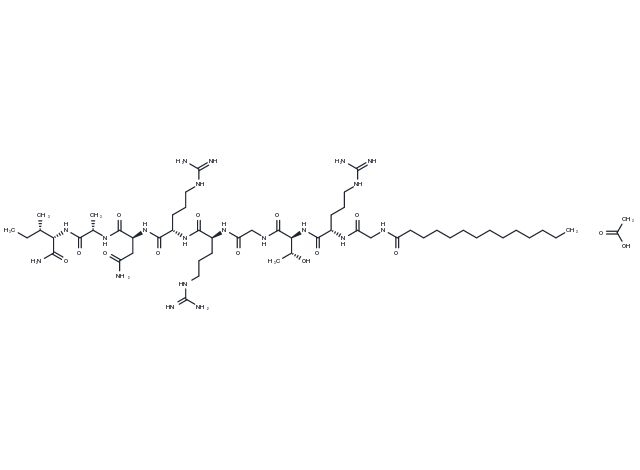keep away from moisture
Powder: -20°C for 3 years | In solvent: -80°C for 1 year

PKI 14-22 amide, myristoylated Acetate inhibit cAMP-dependent protein kinase (PKA) and blocks hyperalgesia produced by spinal administration of 8-bromo-cAMP.

| Pack Size | Availability | Price/USD | Quantity |
|---|---|---|---|
| 1 mg | In stock | $ 298.00 | |
| 5 mg | In stock | $ 671.00 | |
| 10 mg | In stock | $ 997.00 | |
| 25 mg | In stock | $ 1,480.00 | |
| 50 mg | In stock | $ 1,990.00 | |
| 100 mg | In stock | $ 2,690.00 | |
| 1 mL * 10 mM (in DMSO) | In stock | $ 1,290.00 |

| Description | PKI 14-22 amide, myristoylated Acetate inhibit cAMP-dependent protein kinase (PKA) and blocks hyperalgesia produced by spinal administration of 8-bromo-cAMP. |
| In vitro | ?Myristoylated PKI 14-22 amide reduced the IgG-mediated phagocytic response in a manner of dose-dependent.?When the concentration is higher than 10 μM, PKI 14-22 amide can inhibit neutrophil adhesion, which make the phagocytosis measurements impossible to perform |
| Synonyms | PKI 14-22 amide, myristoylated Acetate(201422-03-9 Free base) |
| Molecular Weight | 1269.54 |
| Formula | C55H104N20O14 |
| CAS No. | T21983L |
keep away from moisture
Powder: -20°C for 3 years | In solvent: -80°C for 1 year
DMSO: 55 mg/ml (43.32 mM)
You can also refer to dose conversion for different animals. More
bottom
Please see Inhibitor Handling Instructions for more frequently ask questions. Topics include: how to prepare stock solutions, how to store products, and cautions on cell-based assays & animal experiments, etc.
PKI 14-22 amide, myristoylated Acetate T21983L Tyrosine Kinase/Adaptors PKA PKI 1422 amide, myristoylated Acetate PKI 14 22 amide, myristoylated Acetate PKI 14-22 amide, myristoylated Acetate(201422-03-9 Free base) inhibitor inhibit
